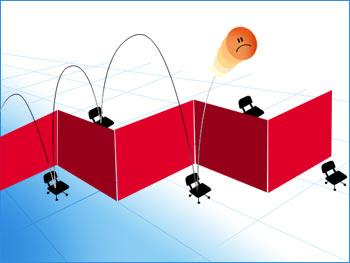
We searched for info about filing a trademark, and came up empty-handed. So we wrote this: the Entrepreneur's Guide to filing a trademark in India.
Why you need a trademark?
A trademark is the mark, logo or trade name which identifies your business to your customers. A trademark registration is valid all over India. Even though the registration of a trademark is not compulsory, it has significant advantages:
1. Registration of the mark creates a presumption of your ownership of the mark. In case someone else violates your trademark, it is much easier to proceed against them if you own a registered trademark.
As an entrepreneur, the return on investment (ROI) on the time and money spent registering your trademark is huge as it does away with the hassle of establishing your trademark in a court if a dispute arises. If you are an online business, your trademark would usually include your domain name.
In fact, getting a trade mark for your domain name is the only effective way of protecting against people who use names sounding similar to yours to get some of your traffic -- the Internet Corporation for Assigned Names and Numbers (ICANN) dispute resolution process is pretty much out of the reach of the average Indian entrepreneur.
Courtesy: 

2. Registration in India will be needed before registering your trademark in other countries.
3. You can only use the @ symbol if you have a registered trademark. (Note if your trademark is not yet registered, you can put symbol next to it).
4. Your trademark and your goodwill is an important part of the value of your business. Any serious investor would do an intellectual property (IP) audit to check whether your IP is sufficiently protected.
How does the process work?
The trademark registration process requires every applicant to specify the categories under which he would like to register her/his trademark. There are 45 categories/classes in all: Classes 1-34 deal with goods, while Classes 35-45 deal with services.
See a list of trademark classes below:
Trademark classes
At the time of filing a trademark, the applicant is required to specify which categories his product/service falls under The Fourth Schedule to Trademarks Rules, 2002.
Classification of goods and services: Name of the classes
(Parts of an article or apparatus are, in general, classified with the actual article or apparatus, except where such parts constitute articles included in other classes).
Class 1. Chemical used in industry, science, photography, agriculture, horticulture and forestry; unprocessed artificial resins, unprocessed plastics; manures; fire extinguishing compositions; tempering and soldering preparations; chemical substances for preserving foodstuffs; tanning substances; adhesive used in industry
Class 2. Paints, varnishes, lacquers; preservatives against rust and against deterioration of wood; colorants; mordents; raw natural resins; metals in foil and powder form for painters; decorators; printers and artists
Class 3. Bleaching preparations and other substances for laundry use; cleaning; polishing; scouring and abrasive preparations; soaps; perfumery, essential oils, cosmetics, hair lotions, dentifrices
Class 4. Industrial oils and greases; lubricants; dust absorbing, wetting and binding compositions; fuels(including motor spirit) and illuminants; candles, wicks
Class 5. Pharmaceutical, veterinary and sanitary preparations; dietetic substances adapted for medical use, food for babies; plasters, materials for dressings; materials for stopping teeth, dental wax; disinfectants; preparation for destroying vermin; fungicides, herbicides
Class 6. Common metals and their alloys; metal building materials;
transportable buildings of metal; materials of metal for railway tracks; non-electric cables and wires of common metal; ironmongery, small items of metal hardware; pipes and tubes of metal; safes; goods of common metal not included in other classes; ores
Class 7. Machines and machine tools; motors and engines (except for land vehicles); machine coupling and transmission components (except for land vehicles); agricultural implements other than hand-operated; incubators for eggs
Class 8. Hand tools and implements (hand-operated); cutlery; side arms; razors
Class 9. Scientific, nautical, surveying, electric, photographic, cinematographic, optical, weighing, measuring, signalling, checking (supervision), life saving and teaching apparatus and instruments; apparatus for recording, transmission or reproduction of sound or images; magnetic data carriers, recording discs; automatic vending machines and mechanisms for coin-operated apparatus; cash registers, calculating machines, data processing equipment and computers; fire extinguishing apparatus
Class 10. Surgical, medical, dental and veterinary apparatus and instruments, artificial limbs, eyes and teeth; orthopaedic articles; suture materials
Class 11. Apparatus for lighting, heating, steam generating, cooking, refrigerating, drying ventilating, water supply and sanitary purposes
Class 12. Vehicles; apparatus for locomotion by land, air or water
Class 13. Firearms; ammunition and projectiles; explosives; fire works
Class 14. Precious metals and their alloys and goods in precious metals or coated therewith, not included in other classes; jewellery, precious stones; horological and other chronometric instruments
Class 15. Musical instruments
Class 16. Paper, cardboard and goods made from these materials, not included in other classes; printed matter; bookbinding material; photographs; stationery; adhesives for stationery or household purposes; artists' materials; paint brushes; typewriters and office requisites (except furniture); instructional and teaching material (except apparatus); plastic materials for packaging (not included in other classes); playing cards; printers' type; printing blocks
Class 17. Rubber, gutta percha, gum, asbestos, mica and goods made from these materials and not included in other classes; plastics in extruded form for use in manufacture; packing, stopping and insulating materials; flexible pipes, not of metal
Class 18. Leather and imitations of leather, and goods made of these materials and not included in other classes; animal skins, hides, trunks and travelling bags; umbrellas, parasols and walking sticks; whips, harness and saddlery
Class 19. Building materials, (non-metallic), non-metallic rigid pipes for building; asphalt, pitch and bitumen; non-metallic transportable buildings; monuments, not of metal.
Class 20. Furniture, mirrors, picture frames; goods(not included in other classes) of wood, cork, reed, cane, wicker, horn, bone, ivory, whalebone, shell, amber, mother- of-pearl, meerschaum and substitutes for all these materials, or of plastics
Class 21. Household or kitchen utensils and containers(not of precious metal or coated therewith); combs and sponges; brushes(except paints brushes); brush making materials; articles for cleaning purposes; steelwool; unworked or semi-worked glass (except glass used in building); glassware, porcelain and earthenware not included in other classes
Class 22. Ropes, string, nets, tents, awnings, tarpaulins, sails, sacks and bags (not included in other classes) padding and stuffing materials(except of rubber or plastics); raw fibrous textile materials
Class 23. Yarns and threads, for textile use
Class 24. Textiles and textile goods, not included in other classes; bed and table covers.
Class 25. Clothing, footwear, headgear
Class 26. Lace and embroidery, ribbons and braid; buttons, hooks and eyes, pins and needles; artificial flowers
Class 27. Carpets, rugs, mats and matting, linoleum and other materials for covering existing floors; wall hangings(non-textile)
Class 28. Games and playthings, gymnastic and sporting articles not included in other classes; decorations for Christmas trees
Class 29. Meat, fish, poultry and game; meat extracts; preserved, dried and cooked fruits and vegetables; jellies, jams, fruit sauces; eggs, milk and milk products; edible oils and fats
Class 30. Coffee, tea, cocoa, sugar, rice, tapioca, sago, artificial coffee; flour and preparations made from cereals, bread, pastry and confectionery, ices; honey, treacle; yeast, baking powder; salt, mustard; vinegar, sauces, (condiments); spices; ice
Class 31. Agricultural, horticultural and forestry products and grains not included in other classes; live animals; fresh fruits and vegetables; seeds, natural plants and flowers; foodstuffs for animals, malt
Class 32. Beers, mineral and aerated waters, and other non-alcoholic drinks; fruit drinks and fruit juices; syrups and other preparations for making beverages
Class 33. Alcoholic beverages(except beers)
Class 34. Tobacco, smokers' articles, matches
SERVICES
Class 35. Advertising, business management, business administration, office functions.
Class 36. Insurance, financial affairs; monetary affairs; real estate affairs.
Class 37. Building construction; repair; installation services.
Class 38. Telecommunications.
Class 39. Transport; packaging and storage of goods; travel arrangement.
Class 40. Treatment of materials.
Class 41. Education; providing of training; entertainment; sporting and cultural activities.
Class 42. Scientific and technological services and research and design relating thereto; industrial analysis and research services; design and development of computer hardware and software.
Class 43. Services for providing food and drink; temporary accommodation.
Class 44. Medical services, veterinary services, hygienic and beauty care for human beings or animals; agriculture, horticulture and forestry services.
Class 45. Legal services; security services for the protection of property and individuals; personal and social services rendered by others to meet the needs of individuals.

Let us say you manufacture shirts under the brand Akosha. If you look at the classes of goods and services, your product would be registered under Class 25: "Clothing, footwear, headgear". This means that you would only be protected against another person/company making any clothing, footwear or headgear under the same brand Akosha or a name which is deceptively similar to that.
It does not mean that someone else cannot use the brand name Akosha for products in other categories (for example: Akosha cricket bats). There are exceptions to this rule, but the simple point is that it is important to choose which categories you would fall under carefully, and check if your business can fall under multiple categories (even in the future).
The more categories you fall under, the better protected you would be. However, before you begin thinking of starting a business called 'Samsung Shirts', please look at "well known" trademarks section below.
Also, word and logo trademarks have to be filed separately. Therefore, you would have to file a trademark for the word "Akosha" under Class 25, and separately for any graphic representation (your logo) of Akosha under Class 25.
Before filing the trademark, it is important to understand that if you file the trademark in your company's name, the trademark will be owned by the company, that is, its shareholders (who might change from time to time).
Therefore, some single founders prefer to get the trademark registered in their own name (and let their company use it under a trademark license agreement).
Once you have understood the basic idea of registering your trademark, it is time to talk to a trademark lawyer. As an entrepreneur, it is generally not be worth your time to go and try to file the trademark yourself.

Costs and choosing a lawyer
Trademark application fees are Rs 2,500 per mark per class. These are paid to the government. Lawyers usually charge anywhere between Rs 1,000 to Rs 3,000 per mark per class in addition to that. So if you file for a word mark and a graphic mark in two classes, it'll cost around Rs 10,000 just in government fees, and another Rs 5,000 to Rs 15,000 on the lawyer's fees.
In addition to this, you will also have to pay for getting a trademark search done to check if there are other similar trademarks. Trademark searches usually cost Rs 500.
It is wise to choose someone experienced and who has been recommended to you: well-identified classes, and a well-drafted application could become crucial in case any dispute arises later. The lawyer also helps you answer any queries that the Trademark Office may come back with and will usually charge separately for it.
Do not hire your regular lawyer -- your school classmate or uncle. Make sure you go to a lawyer who has actually filed trademarks before.

Steps for registering your trademark
Authorise a lawyer to act as your agent. See a sample Power of Attorney.
The lawyer will conduct a search with the Trademark Office to check if there are any similar trademarks already registered under that particular class. There are two kinds of search: online and offline.
It is recommended that you get both the searches done. Make sure the lawyer understands your business and is using the right keywords for this search. See sample offline search's results.
Depending upon the results of the search, the lawyer will draft your trademark application. In case someone already has the same or similar trademark, you may have to change yours. Or if you think that the trademark is rightfully yours, your lawyer will help you oppose that trademark.
These days since most businesses also reserve domain names while registering their companies and brands, so it is generally easy to find out beforehand whether someone else is using an intended trademark.
The lawyer will file your trademark application with the Trademark Office and send you the receipt. See a sample receipt from trademark office.
After a few days, the lawyer will send you the Original Representation Sheet of your trademark as it has been filed with the Trademark Office. See a sample representation sheet.
After this process starts the long wait. It can take anywhere between 18 months to two years for the Trademark Office to decide whether or not to grant you the trademark; if there are objections from the Trademark Office or from anyone else, it may take longer. At the end of this process, your trademark is published in the Trademark Journal.

Some issues which may crop up
So what are the kinds of things that the Trademark Office or other parties could have a problem with?
Descriptive trademark
If you have a descriptive name, it will be difficult to get a trademark for it. For example, if a website called Orange sells oranges, it would not be able to get a trademark for the name orange. A skilled lawyer may be able to draft your application in a way which makes this possible for you (essentially by claiming that you are not selling apples. Don't ask!).
Non-distinctive trademark
Your trademark needs to be distinctive for it to be registered. So it should not be similar to any other existing trademark, that is, a reasonable person should not be confuse your trademark with someone else's. Also, you may have to work a bit on the graphic representation of your trademark to make it more distinctive. It is helpful to add a design to the word logo.
For example, the curved man on the www.naukri.com logo.
Similar to a well-known trademark
While you have to specify classes under which to register your trademark, this does not mean that you can use a well-known trademark for a category other than what it is famous for. For example, Coke is a big brand for beverages, but since it is well known, you cannot use it for your own category, say software.
There are several other grounds on which your trademark may be rejected but these don't come into play very often (example: obscenity, hurting religious sentiment, misuse of emblems etc.).
Trademark offices in India
The following table sets out the different trademark offices in India. You should find a lawyer in the city which is nearest to you for registering your trademark.
1. Trademarks Registry
Trade Marks Registry Mumbai
Intellectual Property Office Antop Hill Post Office,
S.M.Road, Antop Hill,
Mumbai-400 037
2. Trade Marks Registry
Delhi Intellectual Property Office Plot NO.32,
Sector 14,
Dwarka, New Delhi-110075
3. Trade Marks Registry
Kolkata Intellectual Property Office CP-2, Sector V, Salt Lake city, Kolkata-700091
Trade Marks Registry, Chennai
Intellectual Property Office
G.S.T. Road, GuindyChennai-600 032
Trade Marks Registry,
Ahmedabad National Chambers, 15/27,
1st floor, Ashram road,Ahmedabad-380 009